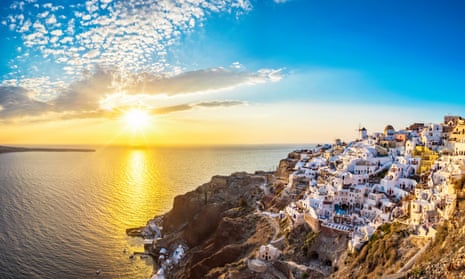Santorini
Viewed from an incoming ferry, the island’s semi-circular volcanic caldera, surrounded by towering reddish-brown cliffs and crowned by whitewashed houses perched perilously above the sea, is awe-inspiring. The black volcanic beaches on the eastern shore, which would be the defining feature of a lesser destination, seem here to be the cherry on the cake.
What to do
It’s tempting to keep gazing at the magnificence of the caldera from the main towns of Oia and Fira like everybody else, but Santorini offers the full spectrum of Greek island experience. The excavated Minoan site at Akrotiri, buried under a volcanic eruption around 1600BC and the probable source of the Atlantis legend, will astonish even the ancient ruin-averse.

Santorini’s vintners have led the way for a new generation of Greek winemakers so wine tasting is a must; try Eastate Argyros for an exceptional experience (€15pp). After you’ve sipped a glass of white assyrtiko with its bold hint of honey and lemon or sampled vinsanto, an amber dessert wine whose sweet preamble opening hides a tannin aftertaste, visit the out-of-the-way Koutsoyannopoulos Wine Museum to learn about this windswept island’s distinctive winemaking history (from €14).
You’ll find forests of beach umbrellas at Perissa and Kamari if that’s your thing, but if you crave privacy, kick off your sandals at Perivolos with its fine soot-like sand. Farther west, Vlychada with its lunar-shaped bluffs is large enough to shelter hundreds, though only dozens stop off. Even more secluded and undeveloped are Vourvoulos and Pori in the north-east – bring your own food and water.
If you fancy watching the island’s legendary sunset, avoid the perennial squeeze at Oia and head to the southern inland coast for an clear view of the caldera and its shifting colours as the sun goes down.
Where to stay
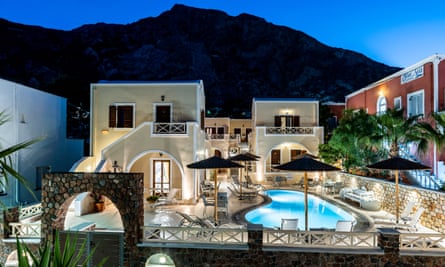
Santorini’s accommodation is eye-wateringly pricey and a balcony with a caldera view can add €200 to your room rate; try Chez Sophie, a budget-boutique family-run hotel laid out around a kidney-shaped pool, 50 metres from Kamari beach (from €77 B&B). Kalimera Hotel in Akrotiri is a tad isolated but has a pool, a bus stop in front of the entrance, and yes, some caldera views (from €117 B&B). If you’re after Fira’s nightlife and aren’t too fussy, Kykladonisia is a converted mansion in the heart of town with smallish rooms featuring traditional furniture (€77.80 room only).
Eat and drink
Brothers Dimitris and Kostas Xrisoxerakis have won over the Ekso Gonia locals with their taverna Metaxi Mas (€25). This is the place to sample Santorini’s authentic “superfood”, fava (yellow split-pea puree), as well as pork in feta sauce and lamb with white aubergines. For the best fish try Vlychada’s To Psaraki, where freshness is paramount; the waiter will advise not only on what’s fresh and what’s pre-frozen, but also whether your choice was caught locally or, alas, “further out in the Aegean” (€50). For a drink in Fira, try the buzzy PK with its jaw-dropping views and lip-smacking cocktails (€12-€15): you can book a table online to watch the sunset (and even click to see the exact view from your reserved seat).
Rhodes
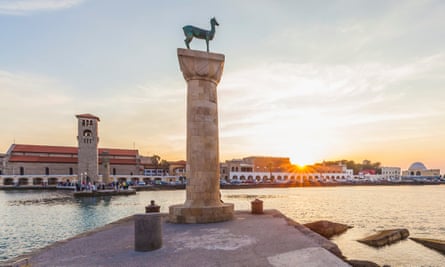
According to legend, the island of Rhodes was named after the bride of Helios, the ancient Greek sun god, who loved her so much that he hardly ever left her side, drenching the island in sunshine for 300 days a year. No wonder Rhodes is a flagship of Greek tourism, flooded with visitors aiming to catch those free-flowing rays.
What to do
Rhodes has a history to match its celebrated beaches. At Mandraki harbour you can imagine the statue of Colossus that once stood proudly above the entrance to the port. Behind you lies the old town, a Unesco world heritage site and the largest inhabited medieval town in Greece, built by the Knights of St John before they fled to Malta. Lindos, the most popular excursion out of Rhodes town, boasts the best-preserved acropolis in Greece outside Athens; it’s situated next to a small bay where St Paul was supposedly shipwrecked on his way to spread the gospel. Rhodes also claims the best examples of Italian colonial architecture, blending elements of Italian ornamental style with Greek and Ottoman features that render them truly unique – art deco meets eastern chic – dating from the interwar years, when the town was groomed as regional capital in Mussolini’s potential Mare Nostrum.

And yet, beyond these historic big hitters, you’d do the island a disservice if you didn’t explore the centre and the south for such exhilarating sights as the 600-acre Valley of Butterflies, where thousands of Jersey tiger moths spend the summer in the shadow of endemic gum trees; the panoramic views from the sanctuary of Zeus near the summit of Atavyros, Rhodes’ highest peak at 1,215m (3,986ft); or the Byzantine frescoes in the monastery of Thari and a slew of standalone country chapels. Among the most impressive of these churches is Agios Nikolaos Foundoukli near the remarkable ghost city of Campochiaro – now Eleousa – built with elegance by the Italians in the 1930s, but abandoned after the second world war.
The farther south you venture, the finer the sand and the fewer the tourists: Agia Agathi, below the village of Kolymbia, will satisfy the most fastidious beachcomber, while the dune-sheltered expanse of Agios Georgios, down the coast from Plimmiri, has a Robinson Crusoe feel. Prasonisi, a sandy spit at the southernmost point of Rhodes, is hard to leave.
Where to stay

History lovers should stay in Niohori, north of Rhodes town’s medieval centre among superb examples of 19th-century Rhodian mansions. Rodos Niohori Luxury Suites is one such mansion that’s been converted to three luxury suites (€170 for two B&B). The simpler Limeri guesthouse in Monolithos makes a good base for day trips in the south (doubles from €77 B&B), while Oasis Prasonisi is a remote beach hotel (doubles from €160 B&B). The colourful F-Charm hotel is in the southern, less touristy part of Lindos and faces the serene St Paul’s Bay (doubles €115, room only).
Eat and drink
Carnivores will love Niohori restaurant by the Catholic church of Santa Maria in Rhodes town. The Tsourounakis family who have run the place since 1981 also own the butcher’s opposite, so the meat is as fresh as it gets (mains €15-€25). Limanaki in Kolymbia is renowned for fish and seafood and has a choose-your-own lobster tank (€25-€50). For trad Greek, try Pezouli in Ialysos (€20-€35); its Greek platter with moussaka, giouvetsi (pasta casserole), rice-stuffed veg, soutzoukakia (spicy meatballs) and baked potatoes is as good an introduction to Greek cooking as it is impossible to finish.
Kos
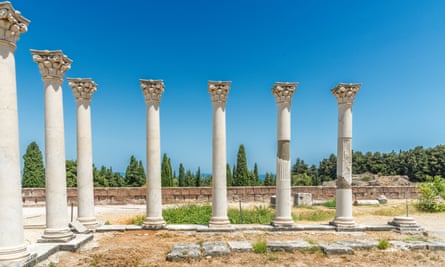
Second only to Rhodes in the Dodecanese in terms of size and tourist numbers, Kos attracts visitors because of its natural beauty: long broad beaches, iridescent water, lush interior, natural springs and fertile gardens (where lots of its famous lettuce is grown), as well as its healthy climate – the summer heat is always tempered by a sea breeze. No wonder it became a curative centre in classical Greece after Hippocrates of Kos, the father of modern medicine, founded his school there.
What to do
Kos town, like Rhodes, is an architectural amalgam of its conquerors: Roman monuments rub shoulders with Ottoman mosques and medieval castles face Italian colonial art deco. The Pompeii-style villa Casa Romana, the Roman Odeon, the Knights of St John castle and the Gazi Hassan Pasha mosque are all must-sees. Yet the island’s unmissable attraction is the Asklepion, 2.5 miles west of Kos town: this archaeological site was the most famous therapeutic centre in antiquity employing the Hippocratic principles of focusing on anatomy and case studies, relying on science rather than religion and following clearly defined medical ethics.
A few miles farther west, however, the mysterious abandoned village of Haïhoutes offers a very different experience. Local lore says it was Armenian, although German archaeologist Ludwig Ross wrote in 1844 that he saw north African villagers there – a tantalising suggestion, as “haik” is the name for a Maghrebi women’s garment.
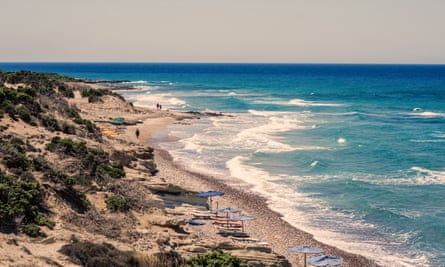
The Hatziemmanouil winery near the busy town of Zipari offers a different kind of outing. Operating since 1929 in the hands of the same family, it produces white Greek wines (malagouzia, assyrtiko) and French red varieties (cabernet sauvignon, syrah).
Birdwatchers should bring their binoculars to Lake Psalidi, populated by a flamboyance of flamingos as well as bitterns, herons, egrets, shelducks and stilts, plus many migratory birds in season. They should also venture to the forest of Plaka – below the village of Antimachia and its breathtaking castle – where peacocks roam wild. For beachy bliss, head to Kefalos in the south-west, only half-discovered by tourism and still full of character, where a great sweep of fine sand stretches northward for about five miles, divided into tribal stretches like Magic Beach (alternative crowd), Exotic Beach (bashful nudists) and Markos Beach (families) – but walk a bit further from the straw parasols and sunbeds and you’ll find yourself sole ruler of the coast.
Where to stay
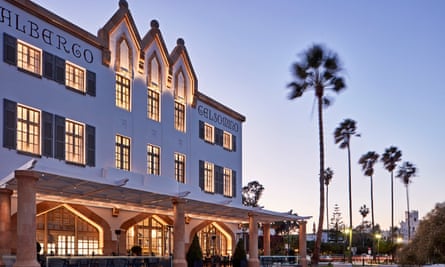
Suave and stylish Kos Aktis in Kos town started off as a Xenia Hotel, the chain built by the Greek state in the 1950s and 1960s and now individually privatised. As the state knew where to build them best, Kos Aktis (doubles €134 B&B) lords it at the top spot of the town beach; rooms have views of the Turkish coast opposite. Hotel Gelsomino is a historic Koan landmark and the first ever hotel on the island. Built in 1928 to house Italian officials, it’s had a chequered history since and was only reopened as a hotel in 2018 after an extensive renovation (doubles from €162 B&B). The adults-only Diamond Deluxe Hotel on Lambi Beach (doubles €188 B&B) has a spa and the gourmet restaurant offers three-course menus for €55pp as well as first-class à la carte options. Simpler but no less fetching are the award-winning Nissia Kamares Hotel Apartments in Kardamena, which remain affordable even in high season (doubles €65.80 B&B, three-night minimum).
Eat and drink
Bored with the usual tavernas? Head to Mylotopi, a renovated farming complex on the edge of Kefalos, comprising a windmill, a thresher, a cellar and a traditional farmhouse, which operates as a gastro-bistro serving Koan specialities (€8-€20). For creative Greek cuisine, reserve a table at Broadway in Kos town to sample dishes like lamb saddle with celery root puree, shimeji mushrooms and coffee, sea bass with cauliflower cream and asparagus, and moussaka croquettes (€8-€20).
Corfu

Greece’s greenest island, Corfu, welcomes visitors with the sweet aroma of pine and lemon trees. In the mountainous interior myrtle and bay bushes fight it out, while venerable olive groves descendto its beach-fringed coastline.
What to do
Corfu town, its old centre a Unesco world heritage site, has a distinct cosmopolitan charm and feels more Italian than Greek – no wonder, since the Ionian islands belonged to Venice, then Napoleon’s France and later Britain, but were never part of the Ottoman Empire.
Don’t miss the Old Fortress, a miracle of medieval Venetian defensive architecture, and the Georgian-style Palace of St Michael and St George, the former seat of the British high commissioner of the Ionian islands, which today houses the incongruous yet fascinating Asian Art museum. Venture into the tangle of alleyways that forms the Mouragia and Campiello neighbourhoods to see the Orthodox and Catholic churches – plus one Synagogue – that bear witness to the island’s multicultural past. Hardcore royal watchers should hurry to Mon Repos, the neoclassical villa where the Duke of Edinburgh was born, reputedly on the dining room table.
A few miles up the coast to the north is Gouvia, with its picturesque marina and a surfeit of fish tavernas, as well as an imposing Venetian arsenal. Or you can head south to Kanoni, a platform high up where a large cannon was mounted, for a glimpse of picturesque Pontikonissi (Mouse Island) – a tiny islet that just manages to fit in a monastery, and whose narrow breakwater extends like a mouse tail. Continuing southwards, Gastouri boasts the Achilleion palace, built by Austro-Hungarian empress Elisabeth (“Sisi”) in 1889 as a mourning retreat after her son, Crown Prince Rudolf, allegedly killed his lover Maria von Vetsera and then himself at Mayerling.
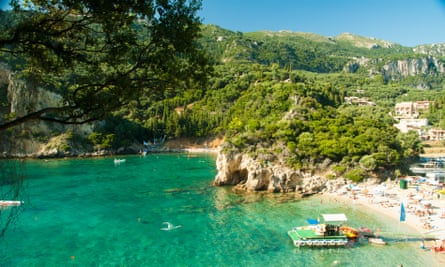
On the west coast Palaiokastritsa may be busy but its beauty is unequalled: lacy beaches, silver-green olive groves, pine-covered hills and natural coves, while Pelekas farther south provides the best sunset spot on the island and is close to less visited sandy beaches such as Glyfada and Kontogialos. Continue south and at Agios Mattheos and you’ll find a primeval oak forest to get lost in; your next stop, Agios Georgios Argyradon lies close to the breathtaking Lake Korission and two great beaches, Chalikounas and Issos. Equally quiet resorts can be found in the south-east: eschew the tourist trap of Kavos and settle on Mesonghi, whose long beach has only partly been appropriated by sun loungers. Drop into the lovely little village of Chlomos, a couple of miles to the south, built amphitheatrically for a wrap-around coastal panorama.
Where to stay
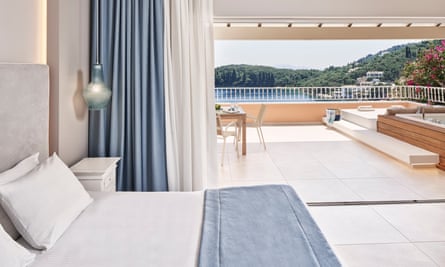
For a quiet resort, opt for adults-only San Antonio in the fishing village of Kalami where the Durrells made their home. Despite being in the TUI catalogue, San Antonio’s prime location and abundance of activities elevates it above package-holiday anonymity (doubles €121 B&B). Villa de Loulia is a classy boutique hotel at Peroulades in the unspoilt north-west with a peaceful pool setting inside a lavish garden (doubles €135 B&B), close to the dramatic Loggas beach with its a vertiginous cliff. Equally tranquil is the excellent-value Labranda Sandy Beach Resort at Agios Georgios Argyradon on the west coast, close to Lake Korission as well as some of Corfu’s best beaches (doubles €132.60 all-inclusive, three-night minimum).
Eat and drink
For a genuine Corfiot experience try Bakalogatos in Corfu old town. It’s an old fashioned tsipouradiko where diners guzzle tsipouro (a form of fruit brandy) and wolf down plates of imaginative meze such as baked potatoes with honey, barbecued Corfiot sausage and fried chicken with prunes (€5-€8 per plate). A more sophisticated seafood-based experience is on offer at Toula’s in Agni Bay with signature dishes like crayfish moussaka, bourdeto (baked spicy scorpion fish) and lobster burgers (€20-€50) as well as a sizeable wine list.
Crete

When planning a visit to Crete, it’s helpful to bear in mind that it becomes less leafy and more arid going west to east and that the beaches are concentrated in the north, while the southern coastline is rugged, as the central mountain range descends abruptly to the sea.
What to do
If time is limited, stay in Heraklion, the capital. Yes, it’s a megalopolis, but it’s the perfect base to explore the essentials. Take an excursion to Knossos, site of the first European civilisation, to admire the palace of Minos, another one to Phaistos, a town that prospered even before the Trojan war, and then visit the Archaeological Museum to piece it all together.
Those with more time could drive westwards along the north coast, past beach resort upon beach resort, to charming Rethymno, whose Ottoman legacy is hard to overlook. The town is also an ideal base from which to visit several historic monasteries in the interior, such as Moni Arkadiou with its unusual baroque main church. Keep going west and you’ll hit Chania, for many the prettiest town in Greece, with a breezy Venetian feel.

For a more authentic experience drive east from Heraklion – avoiding the mega-resorts of Hersonissos, Malia (where The Inbetweeners Movie was shot), Elounda and Agios Nikolaos – to Sitia and the African-looking palm forest of Vaï, all within a Unesco-listed Geopark that offers a chance to discover the real Crete. Beach bums can laze about in any one of a score of stunning beaches like Kouremenos, Alona and Chiona. Hikers can attempt the seven-mile Agioi Pantes Gorge, whose wind-eroded limestone walls look like giant oyster mushrooms, or the lush Richtis Gorge – complete with giant plane trees and a 20-metre waterfall – whose trek ends in a deserted pebble beach. Finally, history buffs will delight in the abundance of little-visited Minoan ruins such as Zakros, Achladia and Makrygialos and will want to explore the innards of the Diktaion Andron cave, the birthplace of Zeus himself, according to myth.
Where to stay
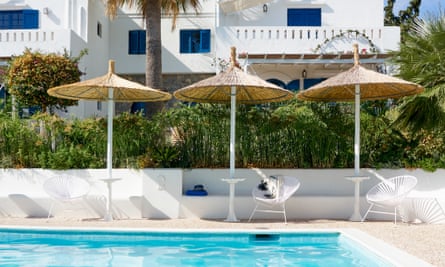
In Chania try to nab a room at the boutique Splanzia Hotel in the old Turkish quarter; its Ottoman furnishings and homely surroundings combine with the bustle of the street outside to create an atmosphere of a Crete long forgotten (doubles €115 B&B). In Rethymno stay at Avli Lounge Apartments, converted from a trio of 16th-century Venetian mansions in the pedestrianised heart of the old town; they include the hotel’s own popular restaurant Avli in a bougainvillaea-strewn courtyard (doubles €135 B&B). To be near the buzz of bars, clubs and restaurants but with a serene refuge, try the adults-only Villa Ippocampi, which has a pool within a walled garden in the hillside village of Koutouloufari, and is only half a mile from Hersonissos (doubles €130 B&B). For seaside lounging, make a reservation at the self-catering White Houses at Makrygialos on the south-eastern coast near Ierapetra, the most unexplored part of Crete. There are tavernas on the doorstep and three good beaches within walking distance (doubles €110.50 room only, two-night minimum).
Eat and drink
Zepos is generally considered the best restaurant in Chania’s Old Port offering modern Greek cuisine. Dishes include fried shrimp with avocado and egg, salad with Valerian leaves, brie, almonds and a berry sauce, and veal stew with tomatoes and aubergines (€15-€45). Heraklion with its explosion of restaurants is the best place to try international and Greek creative cuisine. Xalavro Open Kitchen creates mouthwatering dishes like octopus with fava beans and caper chutney or sea bass with chimichurri and white fish roe (€25-€45). Hersonissos claims one of the best fish restaurants, Saradari, with fresh fish converted into tartare, carpaccio or ceviche, and an incomparable monkfish burger in a squid-ink brioche bun with barbecued shrimp, onions and pickles (€18-€30). Lastly, beach bar-taverna Kleio just outside Ierapetra town is rated highly by the locals for its wood-fired oven that roasts lamb, pork, chicken and goat (€15-€20).
